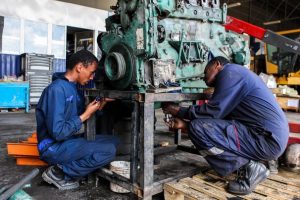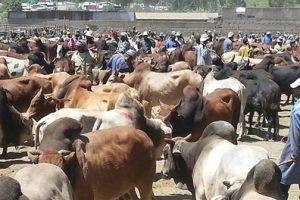
Prime Minister Abiy Ahmed (PhD) responded to questions raised by members of House of People’s Representatives recently on various issues. Regarding economy, he recalled that the government has prepared 10 year’s perspective development plan at the national level that should be cascaded to prepare an action plan. Integrating the plans and applying them for the fruitfulness of the big plan has been underway. There is clear indication for great ardency, thirst, interest and effort to achieve the goal.
Though it encountered forecasted and unexpected national and global manmade and natural disasters while preparing the plan, Ethiopia registered 8.1% economic growth last year. It is above estimation of international financial institutions for Sub Saharan countries to be 4.2%.
This year’s forecast for Sub Saharan African countries is not far from the previous year; but Ethiopia planned to register 8.4% economic growth. The last eight months’ performance of this fiscal year shows good progress as per the plan and if the remaining four months continue in the same pace, total performance will exceed the plan set. Results registered during the last eight months have never been recorded in the history of Ethiopia.
Just to mention at sectoral level, agriculture, which is ranked first among the five pillars that are given high value, needs intervention as it is small scaled alike other countries. Since most of Ethiopian farmers are at Small and medium level, the sector could not grow to commercial farming. Thus, intervention that centers the farmers is essential. As a result of the last five/six years’ effort, crop coverage could grow from 17.5 million hectare to 20.5 million this year alone. This is big progress.
As to the PM, the country began cluster initiative and 8.7 million hectare of land is cultivated up to last year. This coverage has grown to 11.8 million hectare this year. Not only land coverage, the cluster farming also shown progress at high level. To mention only wheat product, 4.2 million hectare of land is covered during the Meher harvest season; 3.5 million hectare in summer irrigation; cumulatively, about 7.7 million hectare of land is covered with wheat this year and nearly 300 million quintals of product is expected.
This success can be taken as a miracle for those stood against wheat importation. It puts Ethiopia at the top in wheat production in Africa. Those who feel sick of this success should swallow the bitter pill that Ethiopia becomes number one wheat producer in the continent, he said.
Besides, the progress registered in coffee, tea and oil seeds during the past few years is encouraging. For instance, at the beginning of the reform, coffee export was about 700 million USD per year. Last year’s coffee export performance, however, was high so that it could earn 1.4 billion USD, the highest accomplishment in Ethiopia’s history of coffee export.
This year, just in eight months, 1.2 billion USD is earned as new coffee trees are added to the farm. Repeating the past performance in the remaining four months will enable the country earn around two billion USD.
Everyone is aware that Ethiopian population has shown great increase and local coffee consumption has also grown simultaneously. Having this in mind, exportation of coffee worth two billion USD indicates that there is radical change in coffee production.
In terms of tea, though it is early to discuss like in coffee, promising work is underway in many rural parts of the country as the farmers clear eucalyptus trees to replace them with tea plantations. What makes tea different from coffee is it is not marketed in its raw form; rather it needs process. In addition to farming, agro processing is essential in this regard.
Rice, oil seeds cultivation and Yelema Tirufat (Bounties of Basket) have shown remarkable progress. The activities underway in Yelema Tirufat, in particular, are promising as experiences of Jigjiga, Bahir Dar, and Assosa indicate in addition to Addis Ababa and its outskirts. Ethiopia is on the right track by starting bulk production in eggs, milk and meat in advance. In so doing, it can counter the current global market crisis.
“Though we do not deny that there is amazing progress as it is a fact, we do not believe that Ethiopia has done sufficient work in Yelema Tirufat, wheat, coffee, and tea. More jobs are ahead of us that need effort. More effort and diligence are expected of us,” the PM said.
In terms irrigation, many mini dams have been constructed, canals are stretched in various parts of the country and many people are engaged in crop production including those embraced in the safety net program. However, irrigation process needs more effort and more project accomplishment progress. Expansion of arable land is also essential as Ethiopia has opportunity to cultivate more land that has not been cultivated yet. And also treating acidic soil with lime is crucial.
In the areas convenient for machinery manipulation, using more machinery is a timely issue. This year, more than 500 machineries are imported free of tax. In the areas not convenient for machinery, other options like terracing and planting fruits is viable. The East Hararghe experience is good indicator in this regard. The surrounding farmers made miracle by changing the difficult landscape even for walk to attractive area by constructing terrace with their hands. The land has begun to hold water and soon will be ready for fruit plantation. As a result, those farmers and their families will gradually reap the fruit and become beneficiary. Performances of last eight months in agriculture sector are found promising.
In the manufacturing sector, different studies and evaluations have been made during the past few years in order to make the sector efficient equals to agriculture. Based on the study, a national string committee is established at the office of Prime Minister. Main task of the committee is taking the sector as a pillar, identifying bottlenecks encountered at all manufacturing levels and providing support.
Among Major bottlenecks the committee identified in about a year, foreign currency deficit is the leading. Lack of sufficient foreign currency input to industry resulted in inefficiency of the sector. The government intervened to minimize the problem. Though not satisfactory, improvements have been seen in foreign currency supply.
The second major bottleneck is energy supply. Industries and factories have been in problem in relation to energy supply. In order to solve the problem, studies were conducted in every industry and factory so that the energy supply problem is solved 100%. For this reason, energy supply for industry sector alone has grown by more than 50% over the last year.
This year, energy supply has increased by 47% at the national level; in the industry sector, it exceeds this amount. The progress in energy demand at this rate every year indicates significance of more effort in energy generation.
Wide range of works has been done in land provision and input supply for the industry sector. To mention some valuable types of commodities, steel for instance, Ethiopia could create 100% capacity in melting scrap and manufacturing forward linkage or end products to provide for its developments. Ethiopia’s problem in steel sector now is supply of ore, its raw material, which is the next focus area.
“As you mentioned earlier, there has been great shortage in cement few months ago. But now, since there is high product, cement factories are asking for export facility by satisfying local demand. On top of decline in price, the excess product seeks foreign market and the government is examining the issue. However, on account of high demand for housing in the country, upgrading the capacity of existing factories and establishing new ones is underway. Expansion of Dangote Cement by two fold has begun in this regard,” Abiy said.
In line with this, among the very important commodity is glass. A lot of works have been done in cutting and shaping glass so far. There are beginnings in glass manufacturing by few investors with the support of government. If the effort began continues to realize 100% production locally like in steel manufacturing, the country will be self sufficient in glass product in the coming few years.
Ethiopia has high potential in ceramics, and especially in granite, and marble. Excelling in these products will benefit the country by saving foreign currency that is wasted not only for purchasing, but also for logistics. Production which was 47% at the beginning has grown to 61% this year; it should grow more. The industry sector has grown by 61%; over 55 factories began operation this year alone and over 120 new factories are licensed. In so doing, like the agriculture, it is trustworthy that the industry will accomplish the plan set.
Comparable to agriculture and manufacturing, the service sector has registered great progress. The Ethiopian Airlines, for instance, has accelerated its profit via expanding airports, adding number of aircrafts, and flight frequencies. It is exerting effort to construct the largest airport in Africa. Upon finalizing preparation, the construction work will begin in the coming five/six months. Other sectors like shipping lines, railway transport, digital market that is grown over 100%, financial sector, tourism and businesses have got chance to be updated more.
In sum, the successes registered in agriculture, industry and service sectors during last eight months as the plan set for this year imply that Ethiopia can achieve the 8.4% economic growth, the PM underlined.
BY BACHA ZEWDIE
THE ETHIOPIAN HERALD WEDNESDAY 26 MARCH 2025





